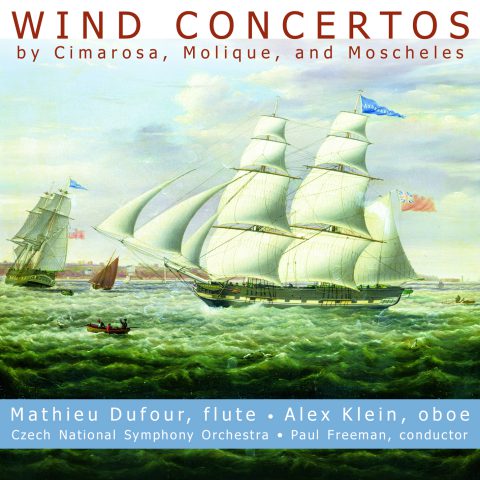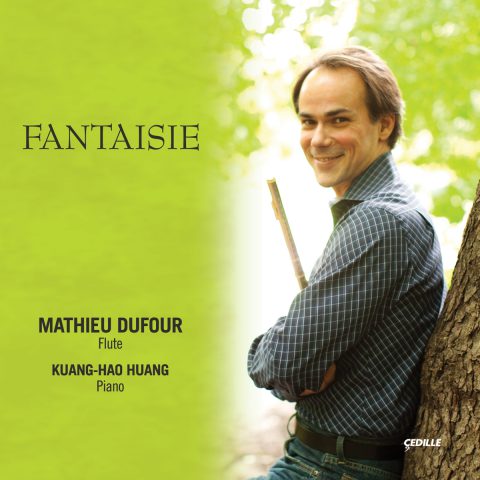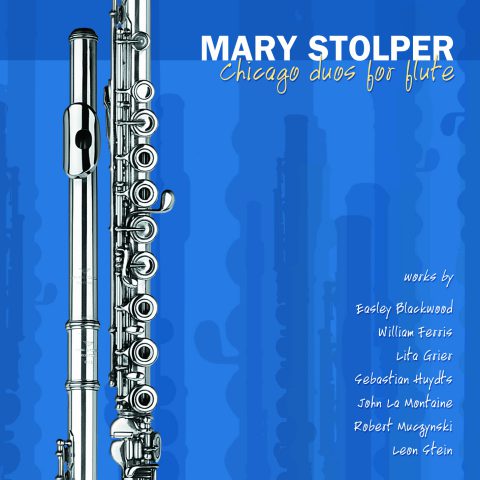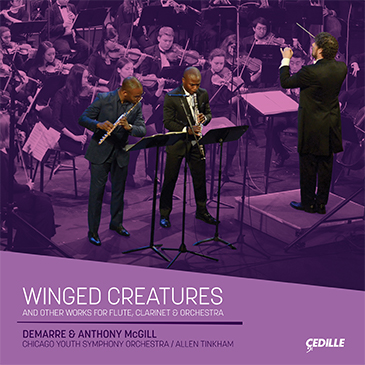Store
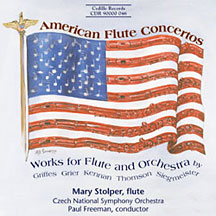
The flute takes center stage on this CD of orchestral works by five American composers of the twentieth century, including the world-premiere recording of a 1996 piece by Chicago’s Lita Grier, an award-winning composer who recently began writing music again after a long absence.
Currently, Ms. Stolper is Principal Flute of the Grant Park Symphony, Chicago Opera Theater, Music of the Baroque and the new music ensemble Fulcrum Point. As an active studio musician she has also played for hundreds of TV and radio commercials. She traveled with the Chicago Symphony for the world-renowned tour of Russia with Maestro Solti (90) and over 15 European/Asian tours with Maestro Barenboim and Boulez. She acted as the principal substitute for the orchestra for over a decade.
Preview Excerpts
LITA GRIER (b. 1937)
Renascence
CHARLES TOMLINSON GRIFFES (1884-1920)
VIRGIL THOMSON (1896-1989)
Concerto for Flute, Strings, Harp, and Percussion
KENT KENNAN (1913–2003)
ELIE SIEGMEISTER (1909–1991)
Concerto for Flute and Orchestra
Artists
Program Notes
Download Album BookletAmerican Flute Concertos
Notes by Ted Hatmaker
The end of the first century of America’s musical independence leaves in its wake vestiges of musical styles that are as diverse as the American people. We could no more put our finger on what is American music than we could define what an American looks like, acts like, or believes in. America’s musical diamond reflects light in countless directions, and each facet claims a valid part of the whole. Throughout the five works on this recording, one hears an array of styles, each distinct, but each an undeniable voice of American music. And while they comprise only a minuscule fraction of America’s total musical output for the twentieth century, their place among American works for solo instrument and orchestra is somewhat more significant; and among American flute concertos they are a most prominent body of works, which speaks to the importance of this collection.
With Renascence, Lita Grier re-emerges triumphantly into the world of composition after a self-imposed exile of over thirty years. Now the President of a Chicago-based art music media company, Grier’s exceptional talent for composition was recognized early: at age sixteen she was awarded First Prize in the New York Philharmonic Young Composers Contest. Despite degrees from Juilliard and UCLA, and studies with Peter Mennin, Lukas Foss, and Roy Harris, Grier abandoned composition in 1964 for other interests. An increasing demand for her earlier works, however, and a more stylistically and gender-inclusive musical climate, have led her back to composition. Renascence, subtitled Concertino for Flute and Orchestra, was reworked from Grier’s 1956 Sonata for Flute and Piano, and constitutes her first opus since her own “rebirth.” Its three movements, Allegro con spirito, Andante, and Presto, while conventional in order, capture a spirit that is patently American. A vibrant syncopation, coupled with running counterpoint and a rococo-like middle theme, characterize the first movement. The second movement is a dream-like sicilienne with broad gestures. The rondo finale possesses jazz and folklike overtones and was inspired by a passage from James Joyce’s A Portrait of the Artist As a Young Man. Throughout, the dancing flute line paints a kaleidoscope of moods within a silhouette of neo-classicism. Flute virtuoso Julius Baker has already declared the piece, “a new classic in the standard flute repertory.” This is its premiere recording.
Completed in 1996, Grier’s is the most recent work on this recording. The earliest, by Charles Tomlinson Griffes, dates from 1918. Poem for Flute and Orchestra was a late work for Griffes, completed two years before his untimely death from pleurisy at age 35. With a life cut short at its most promising point, one can only wonder what such a gifted composer might have produced. Born to a happy middle-class family in Elmira, New York, Griffes turned to composition while studying piano at the Stern Conservatory in Berlin, Germany. A subsequent position as Director of Music at the Hackley School in Tarreytown, New York, allowed him not only time to compose, but also access to New York City and all the contacts necessary to promote his music. Although his works showed masterful ability, he suffered biases both as an American composer and as a modernist. Important breakthroughs in the form of premieres by major symphony orchestras in the autumn of 1919 offered hope for Griffes’ career, but his health was already in decline, exacerbated by the rigors of work necessitated by the premieres’ deadlines. Poem was one of these works, first performed by the New York Symphony Orchestra and its principal flutist, Georges Barrère, for whom it was written. At various times, Griffes’ music displayed influences of late German romanticism, French impressionism, and Far Eastern and Native American musics. Poem’s opening theme, with its natural minor modality, betrays the influence of the latter. A gently undulating flute line draws it toward more impressionistic sonorities and weaves together contrasting airs of mystery and lilting folklike dances.
At the same time that Griffes’ health was failing, Virgil Thomson was coming alive, in a sense, leaving his native Kansas City, Missouri, to enroll at Harvard University in the autumn of 1919. Already an accomplished church organist, Thomson began to compose at Harvard and, influenced by his studies of modern French music, set off for Paris in 1921 to study with Nadia Boulanger. There he met Erik Satie, whose music provided direction for Thomson’s own. After graduating from Harvard in 1923, Thomson returned to live in Paris for sixteen years and began an association with Gertrude Stein, whose writings affected him considerably, and with whom he collaborated on two operas: Four Saints in Three Acts and The Mother of Us All. Upon his return to New York in 1940, he served for fourteen years as music critic for the New York Herald-Tribune. A prolific composer, Thomson is best known for his Stein operas and for musical portraits, some 140 in number, of people in his life. Many are shorter works, but one of the largest, a 1954 portrait of painter Roger Baker, was realized as Thomson’s Concerto for Flute, Strings, Harp and Percussion. The first of its three movements, marked Rapsodico, is entirely for unaccompanied solo flute. Rich in piquancy and embellishments, it is a reflective cadenza, that constitutes what John Cage called “a continuous invention gradually becoming more and more florid.” The second movement is a sullen Lento that pits conflicting string harmonies against each other in a lush web, above which the flute rises. The Ritmico finale begins as a hushed march, with pizzicato strings slowly rising and falling in counterpoint to the flute. The celesta, which had joined the strings near the end of the Lento, now brings other percussion into an increasingly animated rhythm and color. Another flute cadenza ushers in the brilliant final tutti.
Like Thomson, Kent Kennan was born in the midwest (Milwaukee in 1913) and learned organ and piano in his youth. He attended the University of Michigan, where he studied composition with Hunter Johnson, and the Eastman School of Music in Rochester, New York, where Howard Hanson and Bernard Rogers were his mentors. In 1936, he won the American Prix de Rome; during his ensuing three-year stay in the Italian capital, he took lessons with Ildebrando Pizzetti. For most of his life he has held academic positions, most notably at the University of Texas at Austin. Kennan is the author of important textbooks on orchestration and counterpoint. Night Soliloquy, written in 1936, at the time of his Prix de Rome award, is his best known and most performed work. A rare honor for an American composer was bestowed upon Kennan when Arturo Toscanini chose to perform Night Soliloquy with the NBC Symphony Orchestra in 1943. Set for solo flute, strings and piano, its single movement opens with the pulsing of muted strings against a dolorous flute melody that incants its drama, gradually growing in intensity until it bursts forth in a brief monologue, only to recommence its narrative. The echoes of this ethereal discourse fade to nothing against the haunting final tones of the piano.
The extraordinarily fertile life of Elie Siegmeister, composer, conductor, writer, and tireless promoter of American music and social causes, began in New York City in 1909. His education was always directed toward composition; upon earning his B.A. with honors from Columbia College at age eighteen, Siegmeister set off for France to study with Boulanger for four years. After several academic posts, he settled at Long Island’s Hofstra University for 27 years. Siegmeister helped found the American Composers Alliance, served on boards at the American Music Center and ASCAP, and organized a concert at Carnegie Hall in 1968 entitled, “Composers and Musicians for Peace.” He authored texts on contemporary harmony and melody, and on music appreciation. He received numerous awards and commissions, including those from the Ford, Guggenheim, and Rockefeller Foundations, as well as NEA grants. His many works embrace a broad variety of styles, from pure tonality to acrid dissonance, from complex classicism to popular, jazz, and blues idioms. The American Institute of Arts and Letters described his work as “highly charged, admirably crafted, and deeply rooted in the life of the people as well as in his profound emotional experience.” Prompted by the request of a talented, young neighborhood friend of his daughter, Siegmeister began composing Concerto for Flute and Orchestra in 1959, but was interrupted by work on a Hollywood film score (for They Came to Cordura). The concerto was finally completed the following year and premiered by the Oklahoma Symphony Orchestra in 1961. Opening with a plaintive, nostalgic flute melody, the first movement turns playful, then dreamlike, then more vigorous, before a cadenza breaks in and leads us back to recall these moods. The movement concludes with a terse and strident coda. A sultry, blues-like song dominates the second movement. Increasingly exaggerated effects abruptly give way to quiet final strains, which sharply contrast with the quirky, off-beat theme that commences the final movement, marked “fast and rhythmical.” Lively syncopation and cross-rhythms suggest, in the words of the composer, “aspects of cool jazz,” but seem more an angular march. An irregular, dance-like second theme provides distraction, but the incessant, accented march prevails through the work’s explosive conclusion.
Ted Hatmaker is a music theorist on the faculties of Northern Illinois University, DePaul University, and College of DuPage.
Album Details
Total Time: 61:00
Recorded: June 21–24, 1998 at the studios of ICN-Polyart, Prague, Czech Republic
Producer: James Ginsburg
Engineer: Konrad Strauss
Cover: watercolor by Jack Simmerling
Design: Cheryl A Boncuore
Notes: Ted Hatmaker
©1999 Cedille Records/Cedille Chicago
CDR 90000 046
